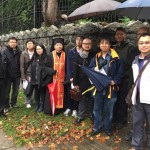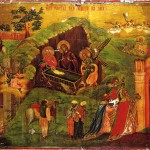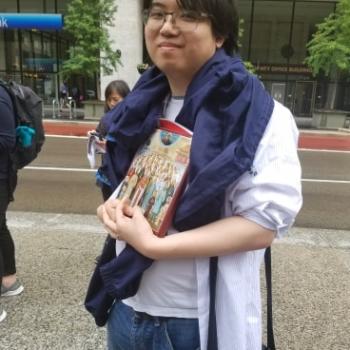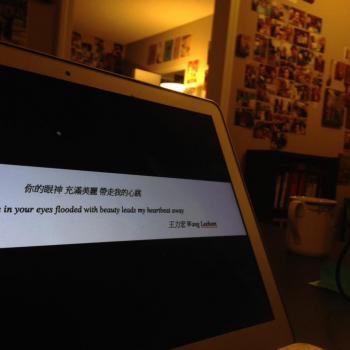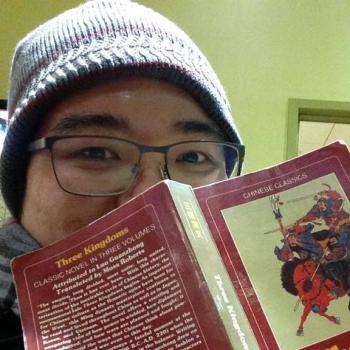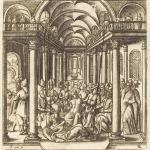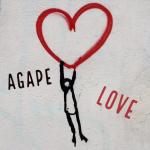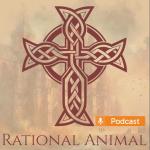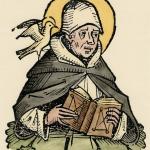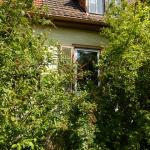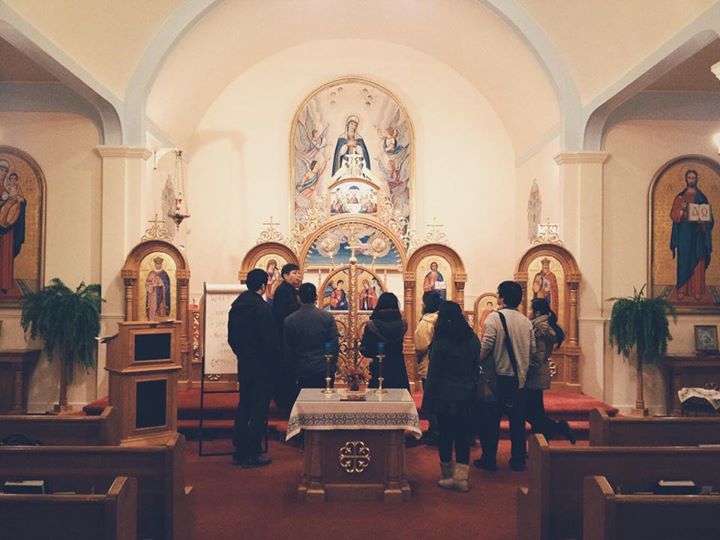
Shortly after the clergy prayer meeting that I wrote about in my last post, the Eastern Jesuit who sort of became our de facto spiritual leader for Chinese Christian solidarity with Hong Kong’s Umbrella Movement messaged me and said that he had an idea. He felt that it was important for people reflecting on the Umbrella Movement to have a space where they could think and pray about their ‘political and social hopes’ in relation to their ‘faith life’ (this is verbatim from the message he first sent me about it), and he thought perhaps it would be helpful to host such an event at his temple, open to all regardless of ideological or theological background.
I thought this was a great idea; little did I know that this would become the first of many such events that I would have a hand in promoting for the temple, especially ones dealing with makrodiakonia – which I first wrote about on this blog while writing about being Eastern Catholic in Asian American studies.
He titled it ‘Faith & Freedom, an “Umbrella” Retreat: 信仰與自由 — 雨傘退修會.’
As usual, I was late. When my wife and I arrived, we couldn’t get the front door open, which is when we realized that though we had driven past this church many times (it is quite near where we live), we had never actually been inside of it. In fact, we assumed that it would look like any normal (Latin) Catholic church because neither of us had ever been inside a Byzantine temple.
Going around the side, we found a side door that was ajar. Perhaps, we thought, this would be a side entrance. Seeing some robes hanging, I surmised this might be the sacristy, so we went in. Maybe I was naive, but the (Anglican) churches that I had been in before this had sacristies off to the side somewhere.
At this point, we found ourselves behind the iconostas (the icon screen). Everyone was looking at us through the doors. The Eastern Jesuit stopped midsentence and turned around. Ah, he said. Welcome.
We began to hesitate a little bit about which door to take; I think I may have begun even to make a dash for the royal doors in the middle. No, go through the side door, said the Eastern Jesuit, because if you go through the middle ones, we’ll have to ordain you. To this day, I still don’t know what he was talking about, although I think after my chrismation, I am starting to get it: in the last step in my chrismation service, I was led through the royal doors to kiss the holy table and then come back out of them as the klyros sang the Song of Symeon in Kyivan chant.
The side door we had walked through, the Eastern Jesuit explained, was called a deacon door. There are two, he said – we had gone through one with the icon of Holy Stephen the Protomartyr, and on the other side was Holy Roman the Melodist. These doors were so named, I recall him saying, because deacons exit and enter the altar through them as they go between the priest and the people. Once again, having never participated in any Byzantine liturgy at this point, I also hadn’t any idea what he was talking about.
We got through the deacon door and took our seats. The Eastern Jesuit was in the middle of flipping through a series of prepared poster-size papers on a white board. I do not remember his lecture blow for blow – it has now been over two years – but I do recall that the premise had something to do with contemplating political phenomena as spiritual matters. In fact, he taught us how Jesuits differentiate between consolations (moments where God’s grace is palpably present) and desolations (moments of deprivation of grace – or even when what the Jesuits call the ‘evil spirit’ is attacking you) as part of a process of discernment, a method that had such an impact on me at the time that when it came time to defending my friend Artur Rosman from defamation around that time, I tried out this method of discernment on my blog. Also, because of the impact of this retreat on my own understanding of discernment, I came to think of Jesuits being Byzantine as quite normal.
I’m going to put words into this Eastern Jesuit’s mouth and call what he taught us the art of political discernment. Discernment, of course, is the technical Jesuit term for sorting out with what kinds of spirits you are interacting at a given moment. As most of the retreat’s attendees were Chinese evangelicals who were used to not talking about politics because we wanted to be spiritual, we were struck by this refusal to divorce spirituality and politics. Some of us thought of this as a purely Catholic thing: there was one Chinese woman in the Latin Church who had family in the underground church in China and spoke about how faith was always a politicized matter for them.
Political discernment, we learned, is just discernment, plain and simple, and it was not just about the Umbrella Movement but could integrate the spiritual politics of the Umbrella Movement with our everyday lives in Vancouver. Oftentimes, discernment is personal: as a person, I want to understand the spirits that I am interacting with. Political discernment simply scales this out to the level of the polis, which is technically what it means to be political (to be concerned with the polis). Put another way, the personal discernment that usually occurs in spiritual direction can be said to be happening at a micro level, and the political might be describing a macro level.
These acts of discernment are a form of service that the church performs for the world, and of course the word service is translated from the Greek diakonia. In so doing, the church can discern what is happening in Hong Kong, Ukraine, and the Americas (among other places – we think of Aleppo also these days, as well as Ankara), and that discernment is diakonia because it is the church walking among the world figuring what spirits are at work in the world. Because the word politics is often conflated (wrongly so!) with partisan, sometimes it is said – as in the Kyivan Church – that such diakonia is in fact the church staying out of politics, but if this is discernment about what spirits are at work in the polis, I don’t really see how this is not political discernment.
It was here that things started getting Byzantine. The Eastern Jesuit began referencing the art of discernment as taught by some of the desert mothers and fathers (I cannot remember which ones), and at one point, we sang the refrain from the Lamentations of Great and Holy Saturday: Arise, O God, and judge the earth, for you shall inherit all the nations. When the retreat ended, the Eastern Jesuit invited all of us up to see the iconostas up close, at which point he explained how the icons were arranged and why the iconostas has peacocks and grapes. He also apologized for the giant leftover reredos screen of the Assumption of the Blessed Virgin from a more latinized era, at which point I joked, ‘You really don’t like assumptions about the Dormition, do you?’ at which point he pointed at me and laughed sarcastically.
I came away from this with a sense that there was something unique about a Byzantine practice of discernment as diakonia. I was unable to articulate it then because I was so unfamiliar with the tradition, but I remember that even then, there was a sense that the liturgy, the Lamentation that we sang, the feasts and the fasts (which the Eastern Jesuit described over tea afterward), the icons, and the study of the desert mothers and fathers weren’t at all separate from this task of discernment. In fact, they were part and parcel of it. As one woman asked during tea, Are we still having Vespers after this? The Eastern Jesuit was incredulous that such a question could even be asked: Of course! It’s Saturday! We have that every Saturday night!
This is where, I think, the macrodiaconal act of political discernment and all the things that people assume I got into Eastern Catholicism for – liturgy, icons, calendar, beauty, mysteries – come together. In response to my friend who said that I had neglected to tell people about how I got into Eastern Catholicism through social justice advocacy, I don’t know if political discernment can actually be separated from the worship of the church. In fact, I think that the Byzantine practices of worship probably carve out a space for discernment, because it is through our liturgies that worshippers are brought into actual spiritual realities as heaven is brought to earth.
Indeed, this is why the church’s political discernment probably should be described more often as diaconal – these are my reflections, not the Eastern Jesuit’s. Just as our deacons go between the altar and the people in the various liturgies of our church – as I learned in a very striking way when I accidentally stepped through the deacon door on my first ever entry into a Byzantine temple – so we who participate in the liturgies go between our temples and the world. This going between can be described as service; it is therefore diaconal, and because this discernment is about the spiritual realities behind political phenomena in the world, it is us the people of G-d participating in the work of makrodiakonia. Of course, lest I be misunderstood, this does not make ordained deacons of us all, but as our Patriarch Sviatoslav writes in his Vibrant Parish pastoral letter, diakonia is one of the hallmarks of a temple where people can encounter the living Christ:
Another important element, which expresses the inner nature of the Church and reveals the vibrancy of a parish is diakonia, which means serving in love or performing “charitable activity.” This service to our neighbor flows from our rootedness in Christ. Active love of neighbor is the vocation and task of each Christian without exception. It is only faith, acting in love, which leads us to salvation (see Gal. 5:6). Faith without works is dead (see James 2:26). “As you did it to one of the least of these my brethren, you did it to me” (Mat. 25:40), – says the Lord Jesus.
Let us look around us – in this world there is so much tragedy and poverty, so much loneliness and sorrow, pain and suffering! All the challenging circumstances of our life on earth – these are for us an invitation to active love, which is an expression of living faith. The Lord wants to open our eyes to the suffering world so that we might learn to truly love and to express God’s love to our neighbor – by our attention to them, by our sincere sympathy, support, by our words of encouragement and good cheer, but mainly, through acts of mercy. It is only then that we can consider ourselves vibrant Christians and our parishes can become places where care is given to the orphan, protection for the widow, help for the poor, and where the suffering of the sick is shared. Thus we will reveal to the world the maternal face of the Church and will become the living sign of the presence of God among humankind, according to the words of St. Augustine: “If you see charity, you see the Trinity.”
The first paragraph above, you will note, is quite microdiaconal: it is about active service to our immediate neighbours. The second paragraph calls us to ‘look around us’ to the world of ‘tragedy and poverty’: that is makrodiakonia. Both scales of diakonia are important, the Patriarch suggests, in a vibrant parish, exercised not only by the deacons but by the whole people of G-d.
I said that I would be reflecting on my own experience of makrodiakonia in Eastern Catholicism on this blog. This latest series of posts has perhaps told some of the stories of my initial experiences with the Eastern Catholic Church that I joined, an encounter facilitated by our encounter with the Umbrella Movement.
But these are just my initial reflections. I have a lot more work to do now that I’ve written all of this, especially as Nativity draws near.

